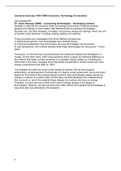Samenvatting
Summary Consumer, Technology and Innovation - Literature (YSS-31806)
Summary of the mandatory literature for the exam of the master course YSS-31806 Consumer, Technology and Innovation. This is a mandatory course for the master MME (Management, Economics and Consumer Studies). I got a 9.5 for the exam with my summaries. This literature summary contains a summary of ...
[Meer zien]




